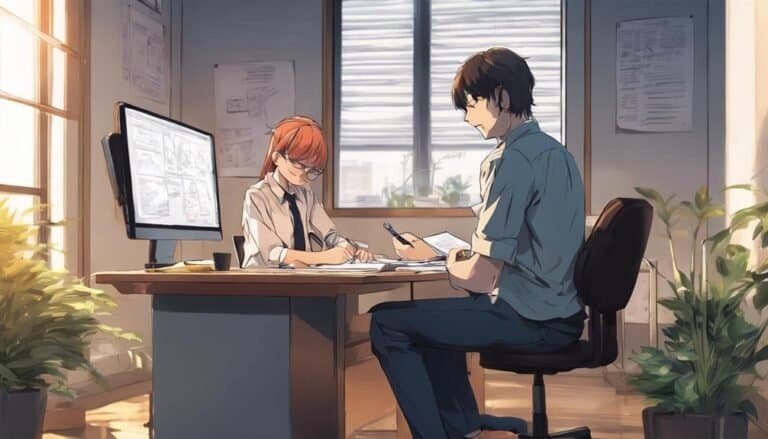Job Duties for Interior Designer
Interior designers play an essential role in shaping the aesthetics and functionality of a space. From collaborating with clients to understand their vision and requirements to meticulously planning layouts and selecting materials, an interior designer's job is multifaceted.
However, these traditional responsibilities are just the tip of the iceberg. The intricacies of managing projects, staying within budget constraints, and ensuring seamless execution require a unique skill set that sets interior designers apart.
But what truly sets a great interior designer apart from the rest? Let's explore further.
Key Takeaways
- Conduct thorough client consultations and needs assessments to understand design vision and requirements.
- Efficient space planning and layout design for optimizing functionality and aesthetics.
- Balance materials and colors for a harmonious space reflecting client style and ambiance.
- Meticulously curate furniture, fixtures, and lighting specifications to enhance the overall design concept.
Client Consultation and Needs Assessment
During the initial stages of a project, interior designers engage in thorough client consultations and needs assessments to gain a holistic understanding of the client's vision, preferences, and requirements. Design inspiration plays a pivotal role in this phase, as designers dig deep into understanding the style, colors, and ambiance the client desires. Client feedback is actively sought and carefully considered to make sure that the design aligns with the client's expectations.
Additionally, interior designers must navigate budget constraints effectively during this phase. Creative solutions are often proposed to meet both aesthetic goals and financial limitations. By proposing cost-effective materials, clever space-saving solutions, and strategic design choices, designers can create spaces that fulfill the client's vision while staying within budgetary restrictions.
Space Planning and Layout Design
Efficient space planning and meticulous layout design are fundamental aspects of an interior designer's role, necessary for optimizing functionality and aesthetics within a given space. Space optimization involves strategically arranging furniture, fixtures, and architectural elements to make the most of the available area. Functionality design focuses on ensuring that the space not only looks good but also serves its intended purpose effectively. Aesthetic appeal plays a critical role in creating visually pleasing environments that reflect the client's style and preferences. Flow efficiency is essential for creating spaces that are easy to navigate and use, promoting a sense of harmony and comfort.
Interior designers must consider factors such as traffic flow, furniture placement, and spatial relationships to create layouts that are both practical and visually appealing. By combining creativity with practicality, designers can transform ordinary spaces into extraordinary ones that meet the needs and desires of their clients. Ultimately, space planning and layout design are key components in shaping environments that are both functional and beautiful.
Material and Color Selection
When it comes to interior design, the selection of materials and colors can truly make or break a space.
From choosing the right color palette to incorporating textures for added impact, interior designers must stay abreast of the latest trends in materials to create stunning and cohesive designs.
Palette Selection Tips
Selecting the perfect palette for interior design involves a meticulous balance of material and color choices to create a harmonious and visually appealing space. Color psychology plays a pivotal role in determining the mood and atmosphere of a room.
Design aesthetics guide the selection of colors that complement each other and enhance the overall design scheme. Cultural influences and design trends also impact palette selection, as different cultures and current design movements often favor specific color combinations and materials.
Understanding these influences allows interior designers to create spaces that resonate with their clients and stay relevant in the ever-evolving design industry. By carefully considering these factors, designers can craft palettes that not only look beautiful but also evoke the desired emotions and responses from those who experience the space.
Textures for Impact
To elevate the impact of interior design, meticulous consideration of textures in both material and color selection is crucial. Incorporating impactful textures into design elements can truly transform a space. Textures such as rough stone, smooth glass, plush velvet, or sleek metal can add depth and visual interest to a room.
When selecting materials, it is important to think about how they will interact with light and the overall ambiance of the space. Combining different textures can create a harmonious balance while adding a touch of luxury or coziness, depending on the desired atmosphere.
Paying attention to textures in material and color selection is a powerful way to enhance the overall design aesthetic and create a memorable space.
Trends in Materials
Incorporating the latest trends in materials and color selection is essential for interior designers seeking to stay ahead in the ever-evolving world of design aesthetics. When considering material and color choices, designers often face the dilemma of natural vs synthetic and sustainable vs traditional options. To create spaces that resonate with modern sensibilities, designers must navigate these contrasts thoughtfully. Here are three key considerations for interior designers:
- Natural vs Synthetic: Choosing between natural materials like wood and stone versus synthetic materials such as laminate and acrylic can have a major impact on the overall look and feel of a space.
- Sustainable vs Traditional: Balancing sustainable options like bamboo flooring with traditional choices like hardwood floors is important for environmentally conscious design solutions.
- Color Psychology: Understanding the psychological effects of color plays an essential role in selecting hues that evoke desired emotions and enhance the overall design concept.
Furniture and Fixture Specification
With meticulous attention to detail and a keen eye for design aesthetics, interior designers meticulously curate furniture and fixture specifications to enhance the overall ambiance of a space. When selecting fabrics and upholstery styles, designers consider not only the visual appeal but also the functionality and durability of the materials. Fabrics can add texture, color, and personality to a room, while upholstery styles can either complement existing decor or serve as a statement piece.
In addition to fabrics, lighting fixtures play an important role in interior design. Designers carefully choose lighting fixtures that not only illuminate the space effectively but also contribute to the overall design concept. From chandeliers to wall sconces, each fixture is selected with the intent of creating a specific mood or highlighting key design elements within the space.
Moreover, hardware finishes are another essential aspect of furniture and fixture specification. Whether it's the finish on drawer pulls, door handles, or light switch plates, these small details can tie the design together and elevate the overall aesthetic of the space. By harmonizing fabric selections, upholstery styles, lighting fixtures, and hardware finishes, interior designers create cohesive and visually stunning environments that meet the needs and preferences of their clients.
Project Coordination and Management
Coordinating and managing interior design projects requires a meticulous approach to guarantee seamless execution and client satisfaction. To excel in project coordination and management, interior designers must prioritize time management, project scheduling, team collaboration, and effective communication strategies.
Here are three essential aspects to take into account:
- Time Management and Project Scheduling: Interior designers need to create detailed project timelines, setting milestones and deadlines for each phase of the project. By effectively managing time and scheduling tasks accordingly, designers make sure that the project stays on track and is completed within the agreed-upon timeframe.
- Team Collaboration: Successful interior design projects often involve various professionals, such as architects, contractors, and suppliers. Collaboration among team members is important for the smooth progress of the project. Interior designers must foster a collaborative environment, encourage open communication, and make sure that all team members work cohesively towards a common goal.
- Communication Strategies: Clear and concise communication is essential for successful project management. Interior designers must effectively communicate with clients, team members, and vendors to convey ideas, address concerns, and provide project updates. Strong communication skills help prevent misunderstandings, establish alignment on project goals, and maintain client satisfaction throughout the design process.
Budgeting and Cost Estimation
As an interior designer, mastering financial planning strategies is vital for success.
By utilizing advanced expense forecasting techniques, designers can accurately project costs and allocate resources efficiently.
Additionally, employing sophisticated cost analysis methods guarantees projects stay within budget constraints while delivering exceptional results.
Financial Planning Strategies
Effective financial planning strategies are essential for interior designers to successfully manage budgeting and cost estimation for their projects. Interior designers need to implement investment planning and budget tracking techniques to make sure that funds are allocated efficiently throughout the project. Financial management plays a vital role in achieving savings goals, allowing designers to deliver high-quality results within the set budget constraints. By establishing a clear investment plan and closely monitoring expenses, interior designers can optimize resources and minimize financial risks. Additionally, setting specific savings goals helps designers stay on track and make informed decisions when it comes to project expenditures. Adopting these financial planning strategies enables interior designers to deliver exceptional outcomes while staying within budget limitations.
- Implement investment planning and budget tracking techniques.
- Focus on financial management to achieve savings goals.
- Set specific savings goals to optimize resources.
Expense Forecasting Techniques
To effectively manage budgeting and cost estimation for interior design projects, interior designers must utilize advanced expense forecasting techniques. Budget tracking techniques play a vital role in ensuring that projects stay within financial constraints.
By utilizing design software tools, designers can accurately estimate costs and track expenses throughout the project lifecycle. Vendor negotiation skills are essential to secure competitive pricing for materials and services, contributing to cost-effective project execution.
Additionally, efficient project timeline management is key to controlling expenses, as delays can lead to increased costs. By incorporating these strategies into their work, interior designers can successfully forecast expenses, maintain budgets, and deliver high-quality designs within financial parameters.
Cost Analysis Methods
Employing meticulous cost analysis methods is imperative for interior designers to effectively manage budgeting and guarantee accurate cost estimation for their projects. When it comes to cost analysis methods in interior design, professionals must consider various factors to assure cost-effective design solutions.
Here are three essential techniques for budget analysis and cost-effective design:
- Detailed Budget Breakdown: Interior designers need to break down the budget into categories like furniture, decor, and labor to track expenses accurately.
- Comparative Cost Analysis: Conducting a comparative analysis of different suppliers and materials helps in choosing the most cost-effective options without compromising quality.
- Continuous Monitoring: Regularly monitoring expenses throughout the project assures that the design stays within budget constraints and allows for adjustments as needed.
Conclusion
To sum up, the role of an interior designer is akin to a skilled conductor orchestrating a symphony of colors, textures, and shapes to create a harmonious and functional living space.
From the initial client consultation to the final project completion, interior designers use their expertise to transform mundane rooms into alluring works of art.
Through meticulous planning and coordination, they breathe life into empty spaces, turning them into vibrant reflections of their clients' personalities and preferences.







